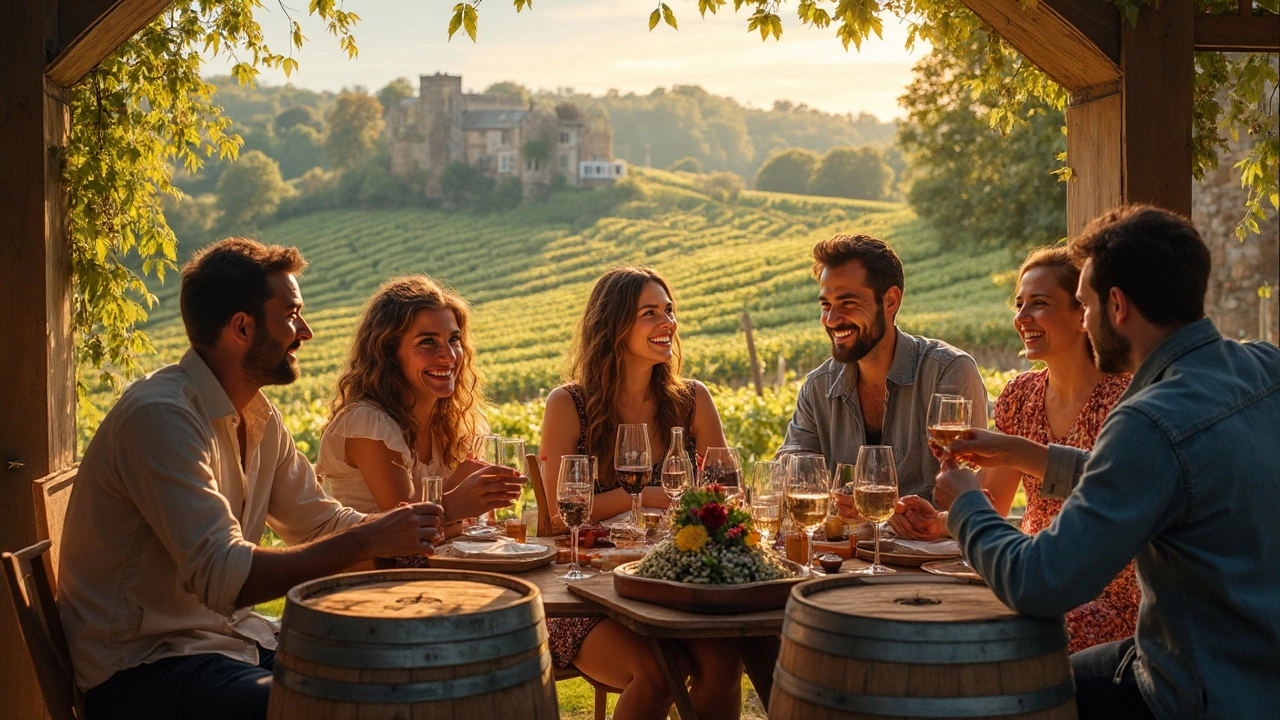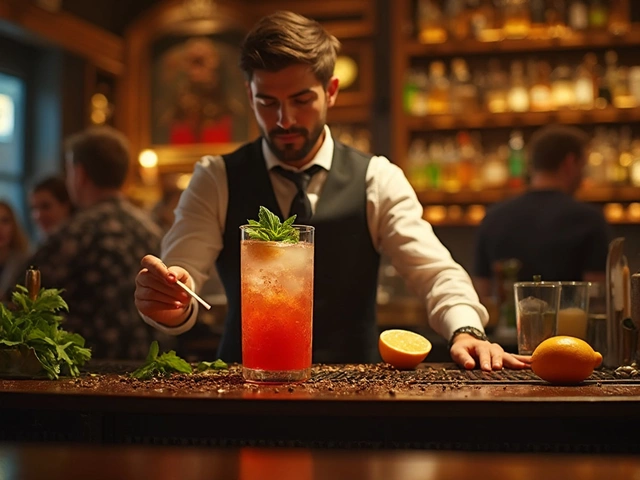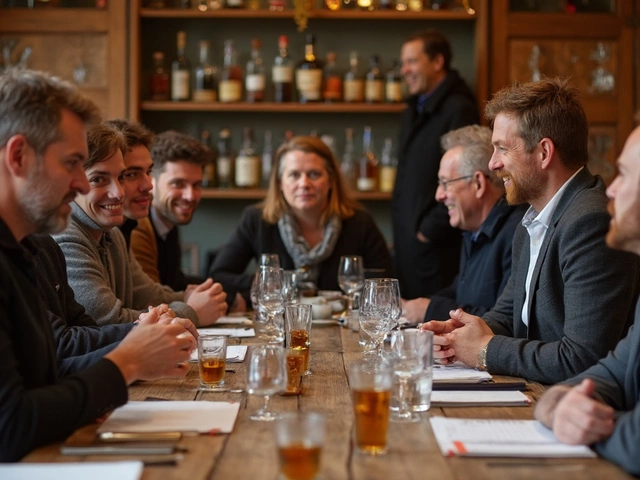Here’s a thing nobody tells you until you’re standing in line at a winery: wine tasting can be as quick or as drawn-out as you want. Most tastings last between 45 minutes and an hour. Seriously, unless you’re doing a power-walk through the line-up, you can knock it out in less than an hour and still feel like you did it right.
If you're hitting up a bigger spot or joining a full-blown tour, block off 90 minutes to two hours. Some tasting rooms let you sit and chat, maybe add cheese and snacks, and suddenly, an afternoon has disappeared. The pace is very different if you’re just popping in for a quick glass or if you’re digging deep with a group, asking the winemaker all those geeky questions.
Knowing this helps you plan—no more showing up late for dinner because your wine tasting lasted way longer than the brochure hinted. Plus, you’ll have a better idea of how many places you can realistically visit in a day without turning your palate into mush. Sticking around for extra pours, chatting up the staff, or booking a private session? Plan to tack on more time.
- Typical Wine Tasting Timeline
- Different Types of Tastings and Their Duration
- What Actually Affects the Tasting Length
- Tips for Planning Your Wine Tasting Day
- Mistakes That Make Tastings Lag or Rush
Typical Wine Tasting Timeline
Most folks who go to a wine tasting for the first time are surprised by how chill the whole thing is—but there’s a general pattern to how it unfolds. You’ll usually spend about 5 to 10 minutes on each wine, tasting four to six wines in a standard flight. Put that together, and you’re looking at 30 to 60 minutes for most wine tasting sessions.
Here’s what usually happens, almost every time:
- Arrival and Check-in (5–10 minutes): You get welcomed, sign in, and sometimes grab a palate cleanser (like a cracker or water).
- Tasting the Wines (30–40 minutes): You’ll move through the line-up—a pour, a quick rundown of the story behind the wine, and then some room to sip and ask questions. Most places include four to six pours for a typical session.
- Extras and Chatting (10–15 minutes): If you’re interested, you can linger, grab another taste, or chat up the staff about the wines or the local vines. This is also when you might decide to buy a bottle (or three).
You might see some tastings wrap up in less than 30 minutes if you’re moving quickly or just not interested in lingering. On weekends, tastings might stretch longer just because things get busier and you’ve got to wait for pours.
| Type of Tasting | Usual Duration | Number of Wines |
|---|---|---|
| Standard Tasting | 45–60 minutes | 4–6 |
| Express Tasting | 20–30 minutes | 2–4 |
| Extended/Private Tasting | 75–120 minutes | 6–8 (often with food) |
Bottom line: a typical wine tasting duration is about an hour. But you’re in control—if you’re on a tight schedule, just let your host know. Want to really dig into each glass? Book more time, or plan for a slower pace.
Different Types of Tastings and Their Duration
Not all wine tastings are built the same. Some are quick, in-and-out affairs, while others have you camped out for the afternoon. Here’s a clear breakdown of the main styles and how much time you’ll actually spend at each one. If you're wondering about wine tasting duration or specifically how long wine tasting sessions last, this comes in handy for planning your day without any timing surprises.
- Bar Tastings: You stand at the counter, usually try four to six wines, and chat a bit with the person pouring. These are streamlined—expect to take about 30 to 45 minutes, maybe even less if you’re moving along or the place is busy. Great for squeezing into a packed itinerary.
- Sit-Down Tastings: Here, you get a seat, and sometimes snacks are involved (think crackers, cheese, maybe even some chocolate). This type encourages you to relax and enjoy the wine at a slower pace. Sessions run from an hour up to 90 minutes, especially if there’s food or bonus pours.
- Guided or Educational Tastings: These are led by someone super knowledgeable—maybe even the winemaker. There’s a structured order, lots of info sharing, and the chance to ask questions. They can last 90 minutes or stretch a bit longer if guests are engaged. Perfect for wine nerds or first-timers who want to learn the ropes.
- Private Tastings: These are by appointment only and really slow things down. There’s usually more wine to try, deeper conversation, and a walk-through of how the wine’s made. These last anywhere from 90 minutes up to two hours. Super popular for special occasions or if you want the full experience without random people around.
- Winery Tours with Tasting: Here it’s not just about sipping—you’ll probably take a walk around the vineyards, see the cellar, and get the story behind each bottle. These sessions can last 90 minutes to two hours, sometimes even longer on weekends when things aren’t so rushed.
Want to see how it actually plays out? Check this quick table comparing the average length for each style:
| Type of Tasting | Average Time |
|---|---|
| Bar Tasting | 30–45 mins |
| Sit-Down Tasting | 60–90 mins |
| Guided/Educational | 75–120 mins |
| Private Tasting | 90–120 mins |
| Winery Tour & Tasting | 90–150 mins |
So, when mapping out your wine route, remember: the more exclusive or involved it gets, the more time you need to put aside. If you love chatting and asking questions, don’t expect to breeze through. But for a no-fuss tasting, those quick bar sessions are your best bet.
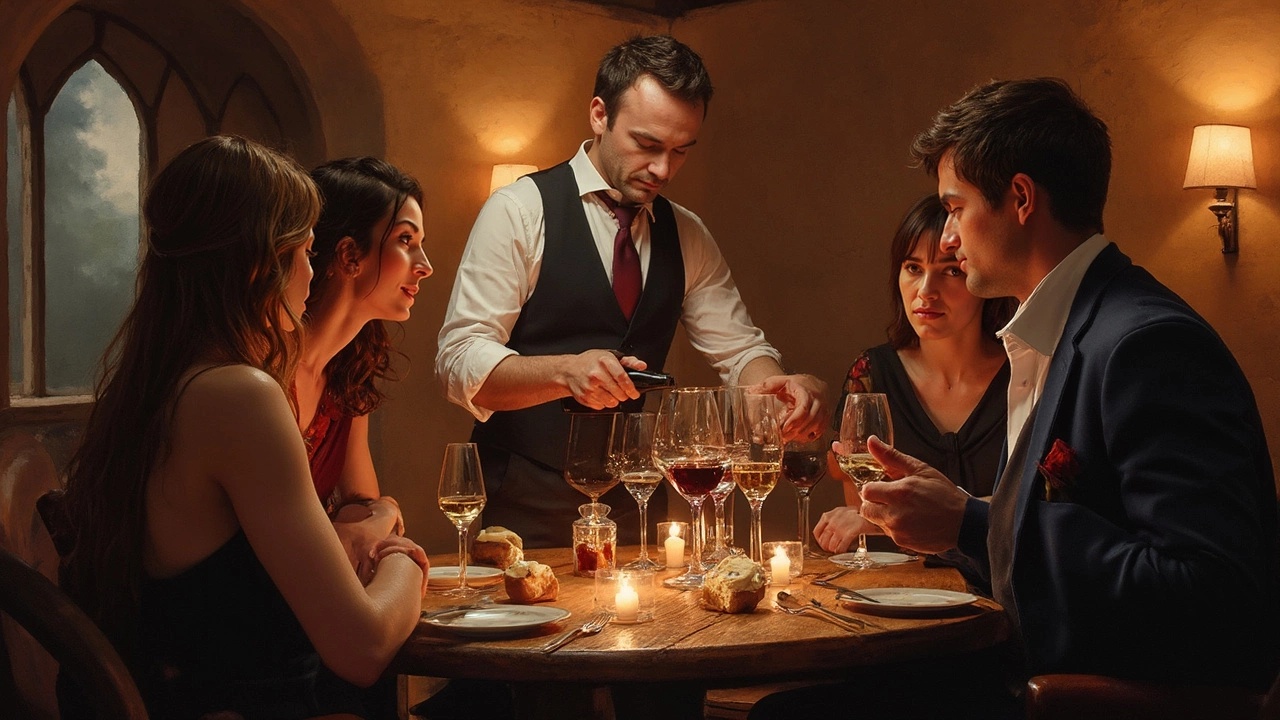
What Actually Affects the Tasting Length
If you’ve ever been surprised by how quick—or long—a wine tasting can be, you’re not alone. The time you spend there actually depends on a bunch of real-world factors—stuff most wineries don’t list online. Let’s break down the real reasons the clock ticks the way it does when you pop in for a tasting.
- Group Size: Solo tasters or couples usually move through the pours faster. Get a group of six or more and, honestly, plan on things running longer. Staff needs time to serve everyone, and people are more likely to chat, compare notes, and snap photos.
- Tasting Format: There’s a big difference between standing at the bar for a splash-and-chat versus a sit-down, guided session. Guided tastings—especially with food pairings or winemaker Q&As—always take extra time.
- Number of Wines: Most standard tastings are five or six pours. But some places love to show off, offering bonus sips or “library wines.” That’s more to drink, and more time spent smiling and pretending you can taste the difference.
- Winery Crowd: On a busy Saturday, expect wait times between pours. Staff can only move so fast when everyone’s there for the same reason. Some wineries smooth this out with extra staff, but it’s not a guarantee.
- Your Experience Level: If you’re new, you’ll probably ask questions (which is awesome), and the host might explain more. If you’re a regular, maybe you’re in and out, no fuss.
Here’s a quick snapshot to give you an idea of standard wine tasting duration based on different situations:
| Type of Tasting | Typical Duration |
|---|---|
| Quick Bar Tasting | 20–30 minutes |
| Sit-down Guided Session | 60–90 minutes |
| Group Tour | 90+ minutes |
Something else to keep in mind: time can slip away if you hit it off with your host or run into a group of chatty guests. Don't let that catch you off guard if you've planned back-to-back appointments. The best advice? Budget a little extra time. Then you won’t stress if the wine tasting takes longer—especially if you’re having fun.
Tips for Planning Your Wine Tasting Day
If you want your wine tasting day to go smooth, it’s all about timing and little bit of prep. Here’s how to nail it every time.
- Book in Advance: Spots with the best views or rare bottles can fill up a week ahead. Especially on weekends, you can’t always just walk in. Check the winery’s website or call before showing up.
- Start Before Noon: Some experts say your taste buds are sharpest late morning. Plus, you beat the crowds and can get more personal attention from the staff.
- Pace Yourself: Planning to visit multiple wineries? Three in a day is usually plenty. By the time you hit the third stop, your palate will start to get tired.
- Designate a Driver: Most wine regions have rideshare, shuttle tours, or at least one friend who’ll take one for the team. You may only drink a few sips at each place, but it adds up if you hit the limit.
- Eat Beforehand and Snack Often: Wine plus empty stomach does nobody any favors. Many tasting rooms offer small bites (and it helps you taste the wine better too).
- Bring Water: Hydrate all day—seriously, water will save you more than once and it keeps your head clear between tastings.
- Don’t Rush: Allow at least an hour per wine tasting. If you want to chat with the staff or see the winery, give yourself extra time.
To give you a quick visual, here’s how typical timing breaks down for a day of wine tasting:
| Activity | Average Duration |
|---|---|
| Single Tasting (Standard) | 45-60 min |
| Guided Tour + Tasting | 90-120 min |
| Travel Between Wineries | 15-30 min (per stop) |
| Lunch Break | 60 min |
If you plan to do more than just taste—like walking through vineyards or booking private tastings—add some wiggle room. It’s way less stressful that way, and you won’t feel hurried for the next stop.
Big takeaways? Don’t overbook, always have a plan for driving, and focus on quality over quantity. That’s how you get the most out of every glass.
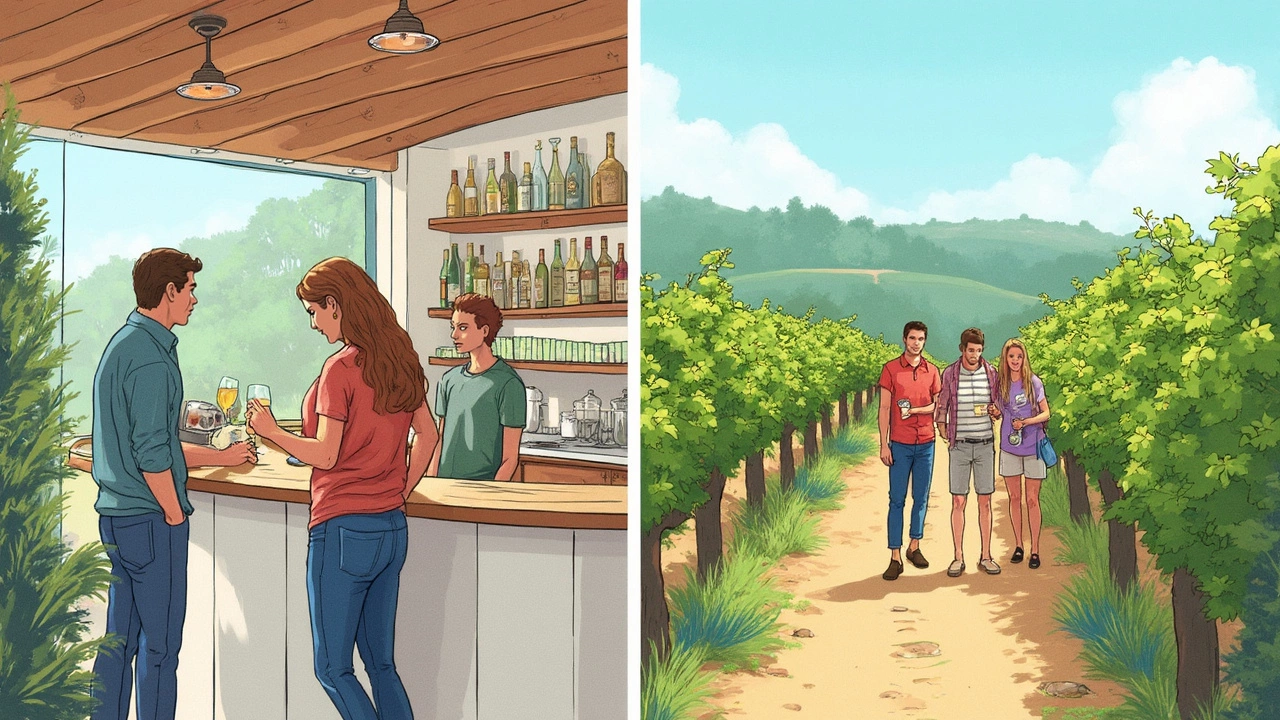
Mistakes That Make Tastings Lag or Rush
The pacing of a wine tasting can swing wildly depending on what folks mess up—or don’t know. Going too slow, you end up bored and possibly tipsy before you even hit the second winery. Going too fast, you barely taste anything and miss what makes each glass special. Here’s what usually throws off the timing:
- Showing Up Late – Wineries often book tastings back-to-back, especially at busy spots. Arrive ten minutes late and suddenly you’re rushed. The staff tries to catch you up, but you barely get a chance to enjoy the wine tasting experience.
- Overbooking Your Day – Trying to fit too many stops into one day is a classic rookie move. Wine tours take time—tasting, chatting, and moving from place to place eats up more minutes than the map says.
- Not Asking Questions at All – If you stand there silent, tastings can feel rushed. Winemakers like to share stories, and you learn a lot with quick questions—even simple ones keep the experience lively and memorable.
- Too Many Distractions – Fiddling with phones, taking loads of photos, or having off-topic chats can drag things out. The tasting loses flow, and before you know it, you’re holding up the group and the next appointment.
- Ordering Extras Without Warning – Deciding to add cheese boards, more glasses, or bottle purchases on the fly? It slows everything down, especially on crowded weekends.
According to a recent survey by Wine Enthusiast Magazine, groups of four who ask at least two questions per tasting spend 20% more time at a winery compared to couples who mostly keep to themselves. That’s not bad if you want the full experience, but something to keep in mind when you’re mapping out your day. Here’s a quick breakdown of common timing issues, based on real tasting room logs:
| Mistake | Added Time Per Tasting (mins) | Impact |
|---|---|---|
| Overbooking wineries | +15 | Leads to rushing, less enjoyable |
| Late arrival | +10 | Less attention, rushed pours |
| Unplanned extras | +12 | Longer wait, more cost |
If you want your wine tasting duration to stay on track, keep questions simple, show up a few minutes early, and plan no more than three wineries in a day. You’ll get to savor the wines instead of watching the clock or missing out.
